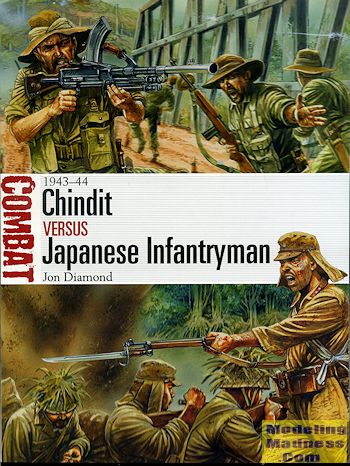Osprey's Chindit vs Japanese Infantry
|
Author: |
Jon Diamond |
|
Publisher |
Osprey |
|
Price |
$18.95 MSRP |
|
Reviewer: |
Scott Van Aken
|
|
Notes: |
80 pages, 7¼ x 9¼
inches, softbound
ISBN: 978-1-4728-0651-2 |
 Next in
Osprey's Combat series is this interesting offering that compares the Chindits
with Japanese Infantry in Burma during 1943/44. This is actually a pretty good
matchup as both forces had to battle the environment as much as they did each
other.
Next in
Osprey's Combat series is this interesting offering that compares the Chindits
with Japanese Infantry in Burma during 1943/44. This is actually a pretty good
matchup as both forces had to battle the environment as much as they did each
other.
The Chindits were the brain-child of Orde Wingate, who championed the use of
Long Range Group (LRG) operations and tactics. This worked well in Palestine and
in the Egyptian/Libyan desert earlier in the war and there was no reason to
think this wouldn't be useful in Burma. Basically, the ideal was for groups to
be self sufficient and to operate behind enemy lines for a period of time,
taking along everything they needed. The earlier operations were relatively
short, lasting a few weeks at most.
This time, it was recommended to send in larger groups and to keep them supplied
while in the field by air. It was a relatively radical idea and was not popular
with most of the brass in the British Army, but it was thought to be well worth
the effort by the British commander in the area, Archibald Wavell. In this
scenario, division sized formations would be sent behind the lines to interrupt
the Japanese lines of communiction and supply, thereby relieving pressure on
Chinese and Indian troops holding the Japanese at bay in the northern and
northeastern sections of the front.
An initial go was made in early 1943 and proved to be relatively successful. A
much larger operation that not only lasted months but allowed the building of
airstrips and 'strongpoints' where the Chindits could receive supplies, remove
wounded and get replacements was undertaken in early 1944. This operation went
somewhat contrary to the plan as the idea of LRGs was hit and run, while the
1944 operation had a major defensive requirement. However, it was also fairly
successful and while the losses on both sides were somewhat high, it managed to
perform its task of weaking Japanese forces in Burma.
While the Chindits were not exactly living in luxury, the Japanese were in worse
condition. Troops in Burma knew they would not get any relief. No
reinforcements, a barely functioning supply chain and continued attrition from
combat and disease, worked against the Japanese in Burma. This was further
exacerbated by typical poor Japanese tactics. Over and over again during the
Pacific war, the Japanese used the same tactics, somehow hoping and repeating
failed plans would eventually lead to success. They threw units into battle
piece-meal and frequently used frontal assaults instead of the enveloping
tactics that were so successful in the early years of the war.
In this book, we look at the background, training and tactics of both sides at
this time. We see the strengths and weaknesses of both sides and get a chance to
read about the progress of the fight and how the soldiers on both side fought
during the battles. It is this look into the make-up of the two armies and how
they put their training to work that really is the heart of this series. We
learn from their actions what worked well and what did not. We see what these
men went through and how the battles affected them and their comrades. The book
covers three major actions. Nankan Station during March of 1943, Pagoda Hill in
March of 1944 and Mougang during September of 1944 show the results of the
deterioration of Japanese troops as the lack of replacements and supplies wreaks
havoc with what, in 1942, was a superbly efficient force. It also shows that the
concept of operating behind the lines had its down side during prolonged
operations.
The book is superbly written and has some very compelling period photos and
superb art work that only enhance what is a well done book. It is a book that draws in the reader and gives
him a sense of what it was like. A book I fully enjoyed reading and can quite
easily recommend to you.
July 2015
For more on the complete line of Osprey books,
visit http://ospreygrp.com. In the US, it is
Osprey Direct at 443 Park Avenue South, New York, NY 10016, where you can
get a catalogue of available books.
If you would like your product reviewed fairly and fairly quickly, please contact
the editor or see other details in the Note to
Contributors.
 Next in
Osprey's Combat series is this interesting offering that compares the Chindits
with Japanese Infantry in Burma during 1943/44. This is actually a pretty good
matchup as both forces had to battle the environment as much as they did each
other.
Next in
Osprey's Combat series is this interesting offering that compares the Chindits
with Japanese Infantry in Burma during 1943/44. This is actually a pretty good
matchup as both forces had to battle the environment as much as they did each
other.